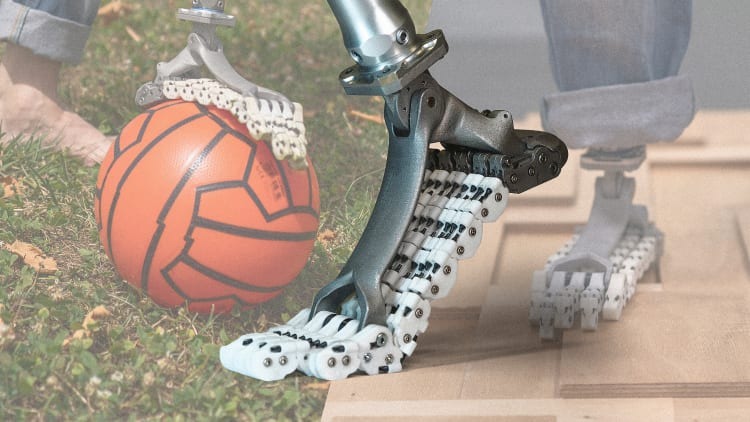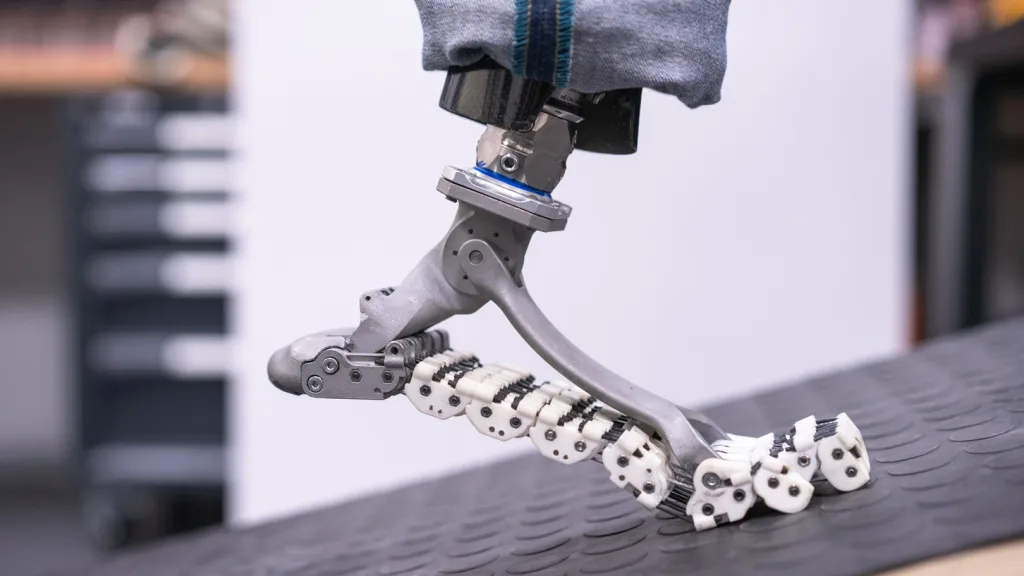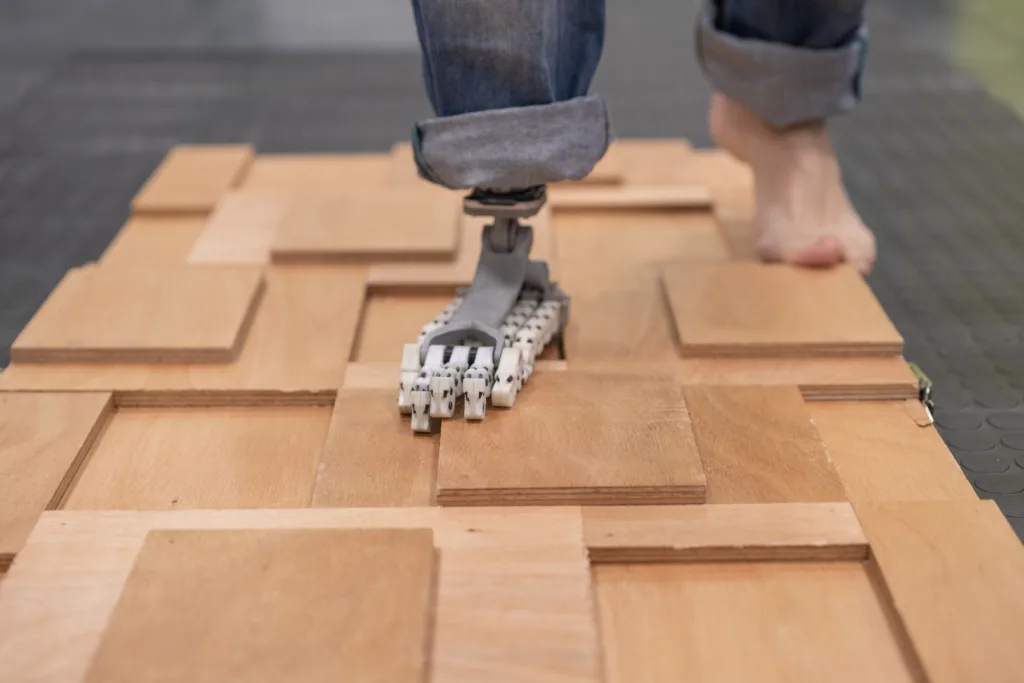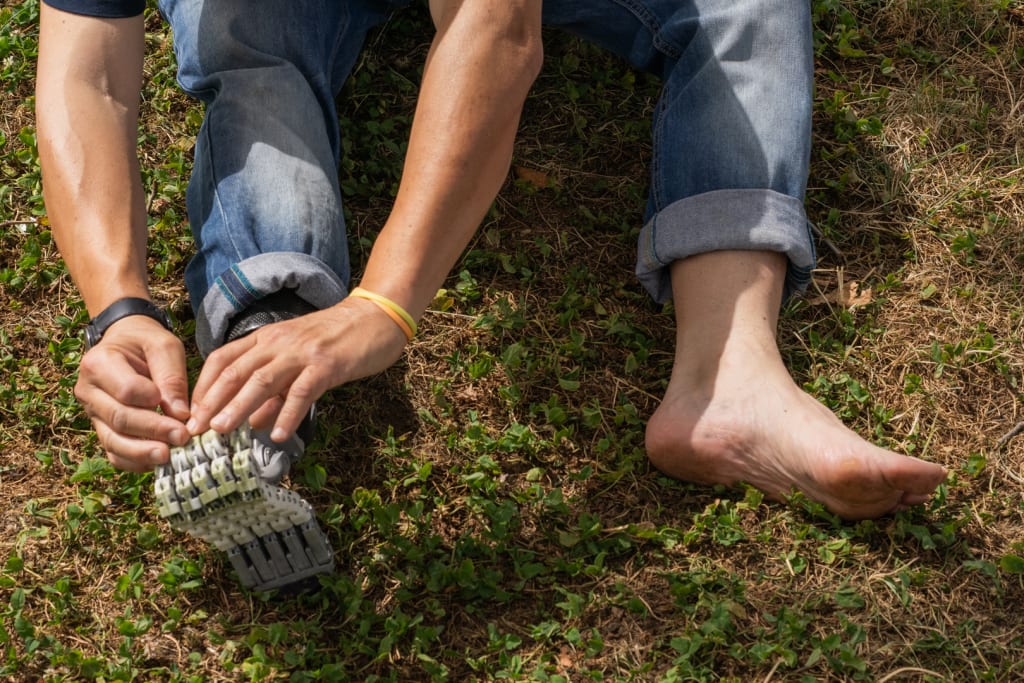- | 8:00 am
This ingenious new prosthetic mimics the bones and ligaments of a human foot
Many prosthetic feet use blades. Here’s why adding toes could help.

The human foot has 26 bones, 33 joints, and over 100 muscles, tendons and ligaments. Yet, most prosthetic feet on the market a consist of a single blade. A new concept from the Italian Institute of Technology in Genoa offers an intriguing alternative.
SoftFoot Pro is a flexible prosthetic prototype that was inspired by the anatomical structure of the human foot. It is made up of five durable plastic chains, each composed of various interlocking elements to reflect individual bones, and arranged in parallel to mimic the skeletal structure of the foot. The chains are connected to the heel—and to one another—through a set of wires and elastics that, together, act as tendons and ligaments.
The result is a prosthetic foot that can be disassembled and repaired easily, and adapt to almost any surface. The design is meant to make it easier for people to go up and down stairs, bend down to tie shoelaces, walk on uneven terrain like a gravel or a woodland path—and even play football. “Usually, [people wearing prosthetic feet] have to concentrate on where to place the foot to maintain equilibrium,” says Manuel Catalano, a researcher in the Soft Robotics for Human Cooperation and Rehabilitation Lab at IIT who led the research. The SoftFoot Pro reduces that cognitive load by making it easier for people to walk without having to constantly look out for rocks on a path or changes in surfaces.

Advancements in prosthetic feet
SoftFoot Pro was developed by the Italian Institute of Technology (IIT) in collaboration with the E. Piaggio Center at the University of Pisa. It is the result of 15 years of research and the extension of another prosthetic—for the hand—called SoftHand Pro. The latter is currently being tested by 35 patients in academic and rehabilitation centers around the world, and it’s already commercialized by an Italian robotics company called qb robotics.
For now, SoftFootPro has only been tested by four individuals with lower limb amputations in the Hannover Medical School in Germany and the Medical University of Vienna, Austria. But initial feedback is promising: “The typical phrase [we hear] is ‘it feels like I regained my foot,’” says Catalano.
Prosthetics have come a long way from the wooden pegs and iron hands of the Middle Ages. Today, people can choose from a wild variety of options including a mind-controlled prosthetic hand that slips on like a glove, a robotic leg that can “switch gears” like a bicycle to help you go up the stairs, and a Swarovski-crystal-encrusted leg that British singer Viktoria Modesta wore while performing at the 2012 Summer Paralympics closing ceremony in London.

The SoftFoot Pro may not be as flashy, or even as high-tech as its counterparts, but it has what a vast majority of others don’t: toes. The metatarsophalangeal joints, otherwise known as toes, play an important role in walking. By flexing and extending our toes, we generate the push-off force that is needed to propel ourselves forward. Other prosthetics mimic this push-off force through flexible blades that are curved at the front, but SoftFoot Pro’s flexible toes—which include springs that store energy when you set your foot down and release it when you lift it—allow for more natural activities like bending down to tie your shoe laces (which naturally involves bending your toes.)
Courtney Moran, a biomedical engineer and certified clinical prosthetist at the Johns Hopkins Applied Physics Laboratory who is behind a sophisticated modular prosthetic arm called the Modular Prosthetic Limb, says that from a mechanical design perspective, the SoftFot Pro prosthetic foot has a “unique design focused on conforming to uneven ground.” The innovation, she says, fills a gap for more “dynamically conforming feet” that are not currently met by other so-called “dynamic” prosthetics.

The biggest challenge remains that most prosthetics cannot provide sensory feedback in a way that feels natural to the patient. This kind of function could help people with lower limb amputations get real-time information about the position of their prosthetic limb, and the surface they’re walking on, which would help them improve their balance and walk more efficiently. ”[Sensory feedback] also provides sensations that we may take for granted and can make a prosthetic device actually become a part of the individual versus simply a tool,” says Moran.
According to Catalano from IIT, sensory feedback could also help reduce the cognitive load associated with having to look down and focus at every step, so his team is currently investigating how to translate information through either electronic signals or more low-tech alternatives.
This part of the research is still in its infancy, but the prosthetic foot has already surpassed Technology Readiness Level 6, which means that the technology has a fully functional prototype and is already being tested in controlled environments. In the meantime, Catalano is pursuing different applications in the robotics industry, like with SoftHand Pro. “The possibility that we have to work on both sides is a powerful tool,” he says.





































